Non-Angry Superficial Draining Veins: A New Technique in Identifying the Extent of Nidus Excision during Cerebral Arteriovenous Malformation Surgery
Abstract
1. Introduction
2. Materials and Methods
2.1. Study Population
2.2. Surgical Technique and Variables
2.3. Statistical Analysis
3. Results
3.1. Clinical Profile
3.2. Intra-Operative Fluorescein Angiography
3.3. Prognosis and Follow-Up Results
4. Discussion
5. Conclusions
Author Contributions
Funding
Institutional Review Board Statement
Informed Consent Statement
Data Availability Statement
Conflicts of Interest
References
- Ondra, S.L.; Troupp, H.; George, E.D.; Schwab, K. The Natural History of Symptomatic Arteriovenous Malformations of the Brain: A 24-Year Follow-up Assessment. J. Neurosurg. 1990, 73, 387–391. [Google Scholar] [CrossRef] [PubMed]
- Lo, W.D.; Hajek, C.; Pappa, C.; Wang, W.; Zumberge, N. Outcomes in Children with Hemorrhagic Stroke. JAMA Neurol. 2013, 70, 66–71. [Google Scholar] [CrossRef]
- da Costa, L.; Wallace, M.C.; ter Brugge, K.G.; O’Kelly, C.; Willinsky, R.A.; Tymianski, M. The Natural History and Predictive Features of Hemorrhage from Brain Arteriovenous Malformations. Stroke 2009, 40, 100–105. [Google Scholar] [CrossRef] [PubMed]
- Tranvinh, E.; Heit, J.J.; Hacein-Bey, L.; Provenzale, J.; Wintermark, M. Contemporary Imaging of Cerebral Arteriovenous Malformations. Am. J. Roentgenol. 2017, 208, 1320–1330. [Google Scholar] [CrossRef]
- Lawton, M.T.; Rutledge, W.C.; Kim, H.; Stapf, C.; Whitehead, K.J.; Li, D.Y.; Krings, T.; terBrugge, K.; Kondziolka, D.; Morgan, M.K.; et al. Brain Arteriovenous Malformations. Nat. Rev. Dis. Prim. 2015, 1, 15008. [Google Scholar] [CrossRef] [PubMed]
- Teo, M.K.; Young, A.M.H.; St. George, E.J. Comparative Surgical Outcome Associated with the Management of Brain Arteriovenous Malformation in a Regional Neurosurgical Centre. Br. J. Neurosurg. 2016, 30, 623–630. [Google Scholar] [CrossRef]
- Firsching, R.; Synowitz, H.J.; Hanebeck, J. Practicability of Intraoperative Microvascular Doppler Sonography in Aneurysm Surgery. Min-Minim. Invasive Neurosurg. 2000, 43, 144–148. [Google Scholar] [CrossRef]
- Tong, X.; Wu, J.; Cao, Y.; Zhao, Y.; Wang, S. New Predictive Model for Microsurgical Outcome of Intracranial Arteriovenous Malformations: Study Protocol. BMJ Open 2017, 7, e014063. [Google Scholar] [CrossRef]
- Kato, Y.; Balamurugan, S.; Agrawal, A.; Sano, H. Intra Operative Indocyanine Green Video-Angiography in Cerebrovascular Surgery: An Overview with Review of Literature. Asian J. Neurosurg. 2011, 6, 88–93. [Google Scholar] [CrossRef]
- Faber, F.; Thon, N.; Fesl, G.; Rachinger, W.; Guckler, R.; Tonn, J.-C.; Schichor, C. Enhanced Analysis of Intracerebral Arterioveneous Malformations by the Intraoperative Use of Analytical Indocyanine Green Videoangiography: Technical Note. Acta Neurochir. 2011, 153, 2181–2187. [Google Scholar] [CrossRef]
- Taddei, G.; Tommasi, C.; Ricci, A.; Galzio, R. Arteriovenous Malformations and Intraoperative Indocyanine Green Videoangiography: Preliminary Experience. Neurol. India 2011, 59, 97–100. [Google Scholar] [CrossRef] [PubMed]
- Zaidi, H.A.; Abla, A.A.; Nakaji, P.; Chowdhry, S.A.; Albuquerque, F.C.; Spetzler, R.F. Indocyanine Green Angiography in the Surgical Management of Cerebral Arteriovenous Malformations. Oper. Neurosurg. 2014, 10, 246–251. [Google Scholar] [CrossRef] [PubMed]
- Catapano, G.; Sgulò, F.; Laleva, L.; Columbano, L.; Dallan, I.; de Notaris, M. Multimodal Use of Indocyanine Green Endoscopy in Neurosurgery: A Single-Center Experience and Review of the Literature. Neurosurg. Rev. 2017, 41, 985–998. [Google Scholar] [CrossRef] [PubMed]
- Fukuda, K.; Kataoka, H.; Nakajima, N.; Masuoka, J.; Satow, T.; Iihara, K. Efficacy of FLOW 800 with Indocyanine Green Videoangiography for the Quantitative Assessment of Flow Dynamics in Cerebral Arteriovenous Malformation Surgery. World Neurosurg. 2015, 83, 203–210. [Google Scholar] [CrossRef] [PubMed]
- Feng, S.; Zhang, Y.; Sun, Z.; Wu, C.; Xue, Z.; Ma, Y.; Jiang, J. Application of Multimodal Navigation Together with Fluorescein Angiography in Microsurgical Treatment of Cerebral Arteriovenous Malformations. Sci. Rep. 2017, 7, 14822. [Google Scholar] [CrossRef] [PubMed]
- Kato, N.; Prinz, V.; Dengler, J.; Vajkoczy, P. Blood Flow Assessment of Arteriovenous Malformations Using Intraoperative Indocyanine Green Videoangiography. Stroke Res. Treat. 2019, 2019, 7292304. [Google Scholar] [CrossRef] [PubMed]
- Ye, X.; Wang, L.; Li, M.; Chen, X.; Wang, H.; Ma, L.; Wang, R.; Zhang, Y.; Cao, Y.; Zhao, Y.; et al. Hemodynamic Changes in Superficial Arteriovenous Malformation Surgery Measured by Intraoperative ICG Fluorescence Videoangiography with FLOW 800 Software. Chin. Neurosurg. J. 2020, 6, 29. [Google Scholar] [CrossRef]
- Ng, Y.P.; King, N.K.; Wan, K.R.; Wang, E.; Ng, I. Uses and Limitations of Indocyanine Green Videoangiography for Flow Analysis in Arteriovenous Malformation Surgery. J. Clin. Neurosci. 2013, 20, 224–232. [Google Scholar] [CrossRef]
- Takagi, Y.; Kikuta, K.; Nozaki, K.; Sawamura, K.; Hashimoto, N. Detection of a Residual Nidus by Surgical Microscope-Integrated Intraoperative Near-Infrared Indocyanine Green Videoangiography in a Child with a Cerebral Arteriovenous Malformation. J. Neurosurg. Pediatr. 2007, 107, 416–418. [Google Scholar] [CrossRef]
- Hänggi, D.; Etminan, N.; Steiger, H.-J. The Impact of Microscope-Integrated Intraoperative Near-Infrared Indocyanine Green Videoangiography on Surgery of Arteriovenous Malformations and Dural Arteriovenous Fistulae. Neurosurgery 2010, 67, 1094–1104. [Google Scholar] [CrossRef]
- Hoya, K.; Asai, A.; Sasaki, T.; Kimura, K.; Kirino, T. Expression of Smooth Muscle Proteins in Cavernous and Arteriovenous Malformations. Acta Neuropathol. 2001, 102, 257–263. [Google Scholar] [CrossRef] [PubMed]
- Kalyvas, J.; Spetzler, R.F. Does FLOW 800 Technology Improve the Utility of Indocyanine Green Videoangiography in Cerebral Arteriovenous Malformation Surgery? World Neurosurg. 2015, 83, 147–148. [Google Scholar] [CrossRef] [PubMed]
- Sturiale, C.L.; Puca, A.; Calandrelli, R.; D’Arrigo, S.; Albanese, A.; Marchese, E.; Alexandre, A.M.; Colosimo, C.; Maira, G. Relevance of Bleeding Pattern on Clinical Appearance and Outcome in Patients with Hemorrhagic Brain Arteriovenous Malformations. J. Neurol. Sci. 2013, 324, 118–123. [Google Scholar] [CrossRef] [PubMed]
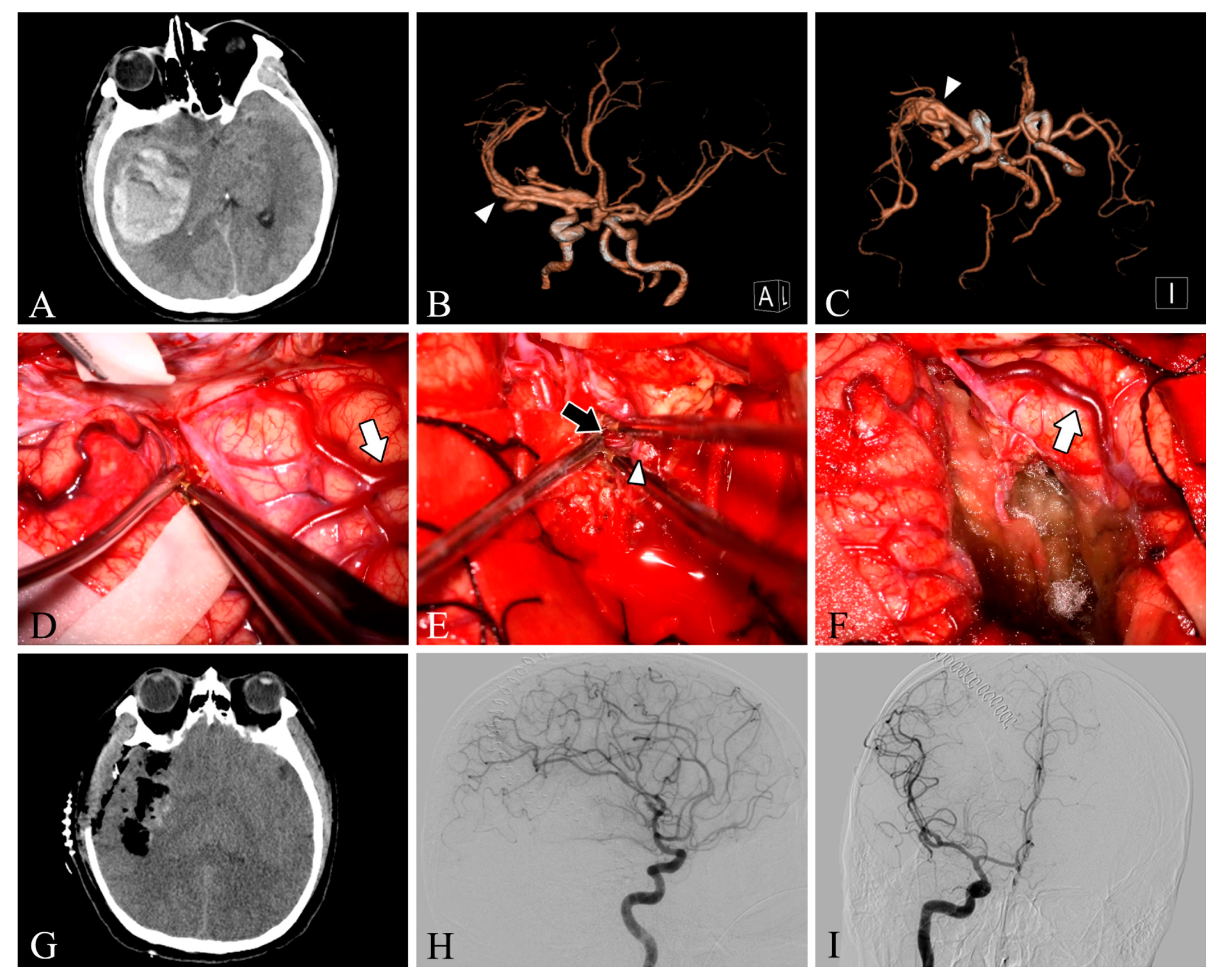

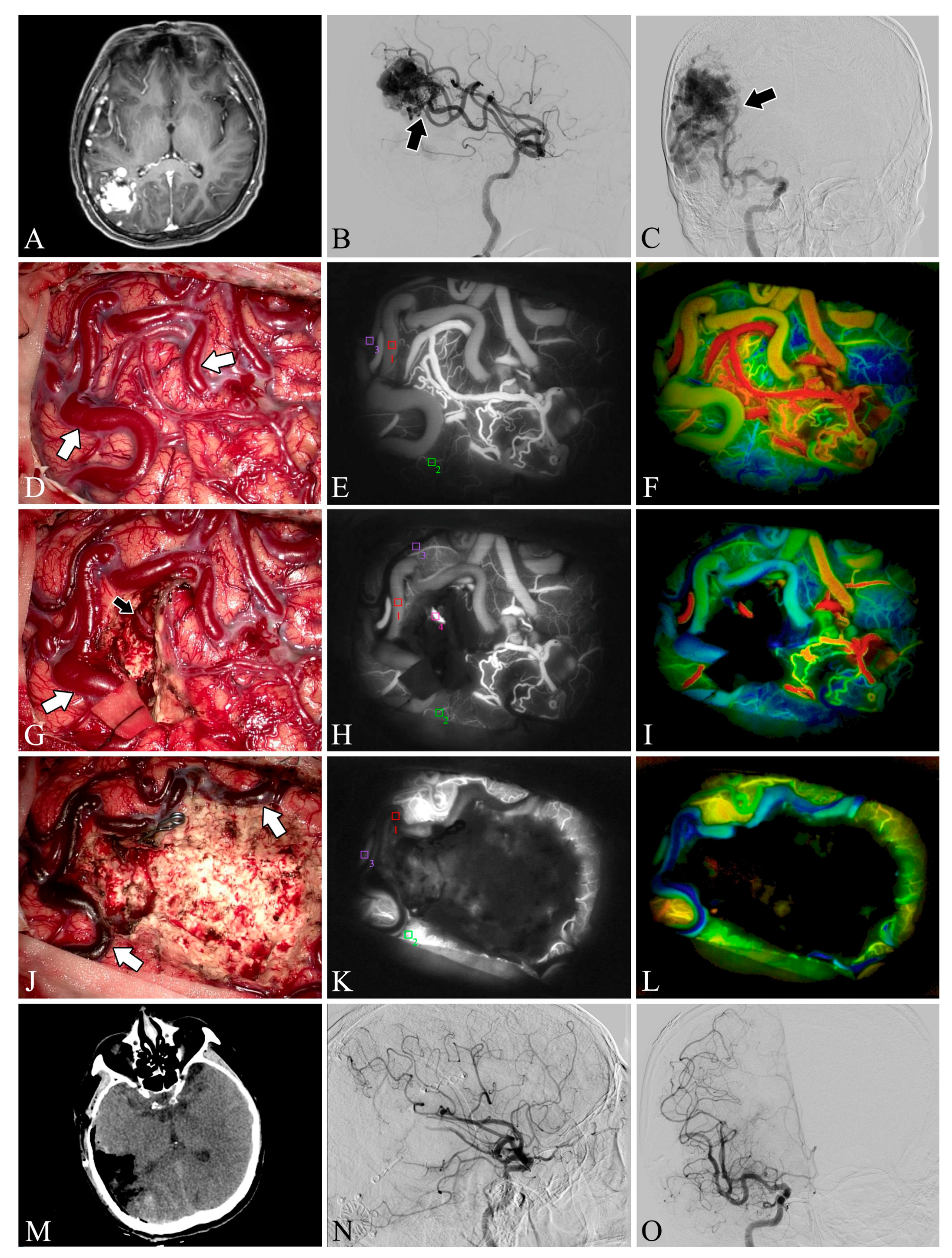
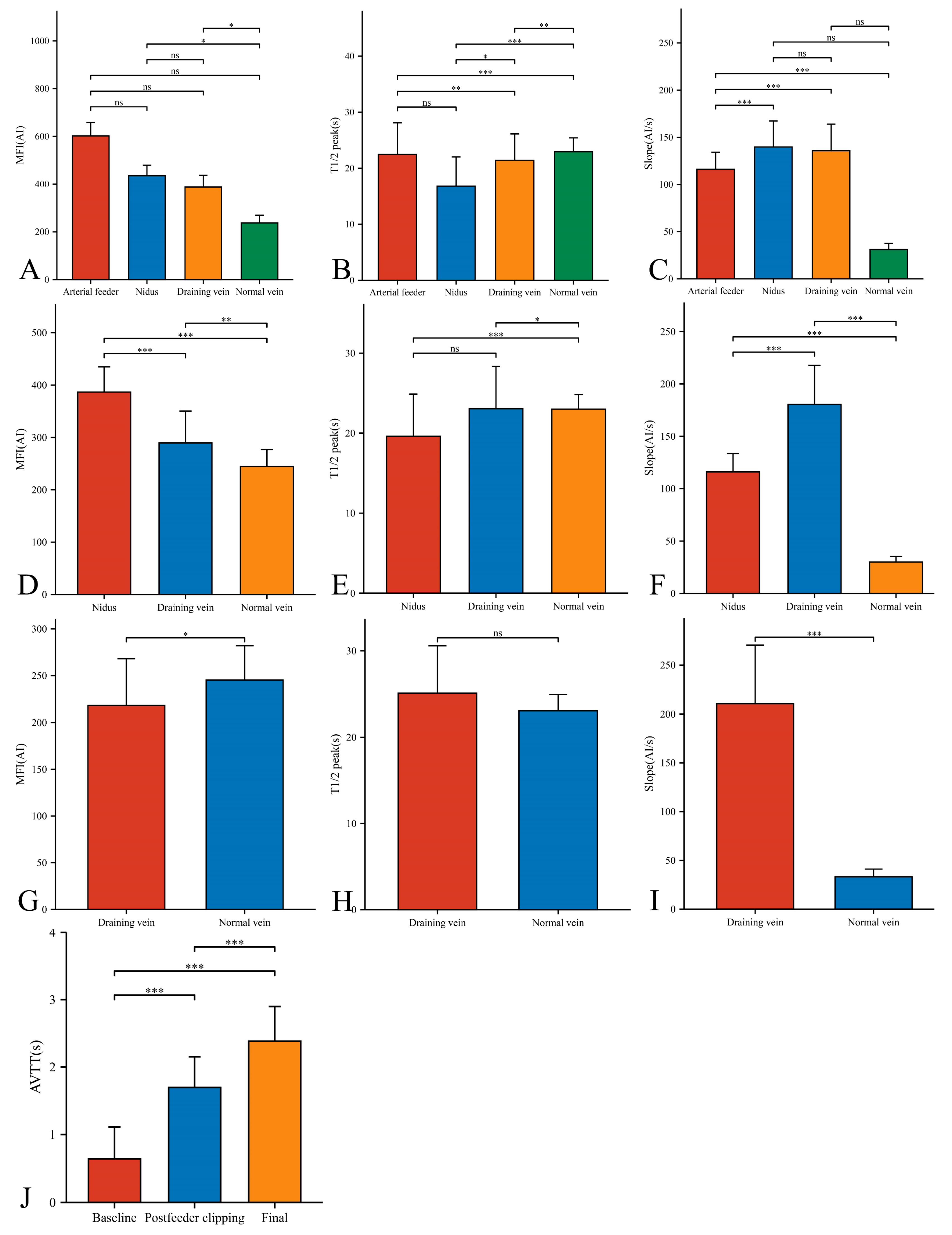
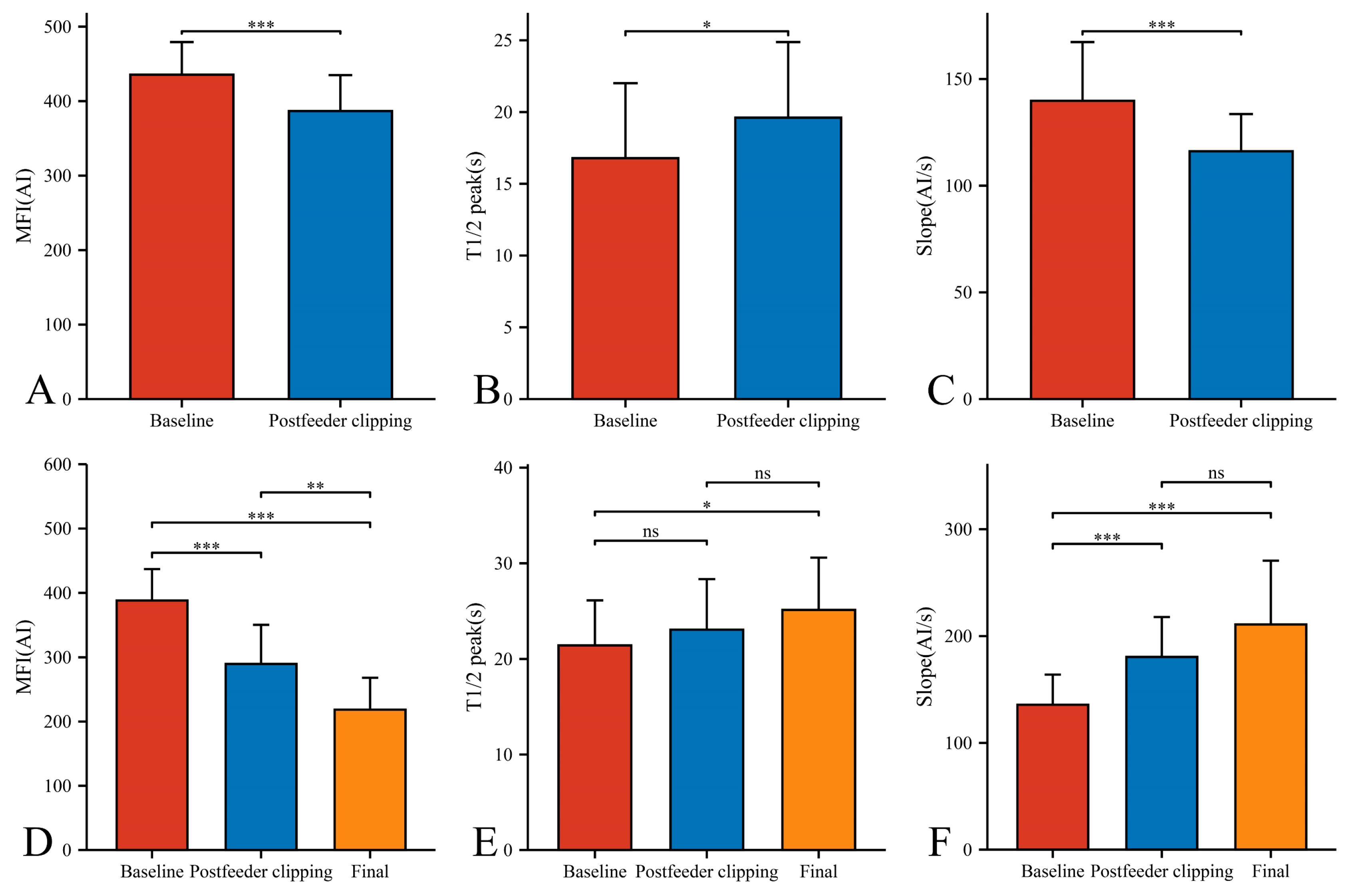
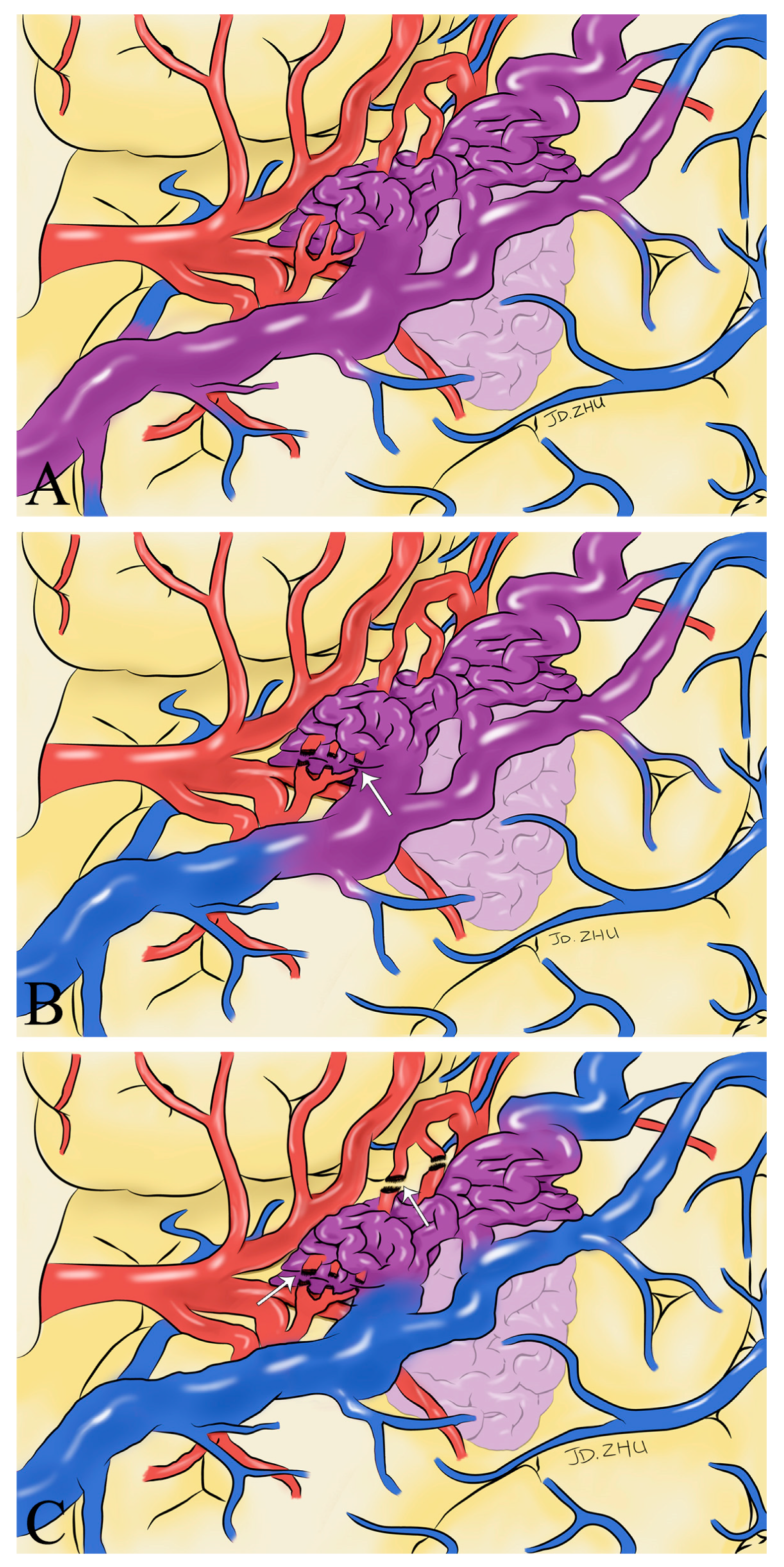
| Visualization | mRs Score | |||||||||
|---|---|---|---|---|---|---|---|---|---|---|
| Case NO. | Age, Sex | S-M | Location (Nidus) | Presentation | Size (mm) | NO. of Feeders | Nidus | Drainer | Pre- Operative | Follow- Up |
| 1 | 21, M | 2 | Parietooccipital | Headache | 21 × 56 × 40 | 4 | Yes | Yes | 1 | 0 |
| 2 | 19, M | 3 | Occipital | Headache | 41 × 35 × 45 | 2 | Yes | Yes | 1 | 1 |
| 3 | 37, M | 2 | Frontal | Headache | 15 × 14 × 33 | 2 | Yes | Yes | 3 | 1 |
| 4 | 26, M | 1 | Cerebellum | Headache | 11 × 8 × 9 | 1 | Yes | Yes | 2 | 0 |
| 5 | 14, M | 2 | Parietooccipital | Headache | 28 × 36 × 30 | 1 | Yes | Yes | 4 | 2 |
| 6 | 48, M | 2 | Frontal | Unconsciousness | 27 × 20 × 15 | 1 | Yes | Yes | 5 | 3 |
| 7 | 27, F | 3 | Frontal | Epilepsy | 21 × 35 × 25 | 1 | Yes | Yes | 1 | 1 |
| 8 | 31, F | 1 | Parietal | Incidental | 20 × 23 × 20 | 1 | Yes | Yes | 0 | 0 |
| 9 | 24, M | 3 | Frontal | Epilepsy | 31 × 29 × 35 | 1 | Yes | Yes | 1 | 0 |
| 10 | 49, M | 1 | Occipital | Headache | 18 × 14 × 15 | 1 | Yes | Yes | 2 | 2 |
| 11 | 46, M | 1 | Occipital | Unconsciousness | 21 × 22 × 20 | 1 | Yes | Yes | 5 | 3 |
| 12 | 46, M | 3 | Temporal | Epilepsy | 34 × 28 × 20 | 2 | Yes | Yes | 1 | 0 |
| 13 | 64, M | 3 | Frontoparietal | Dizzy | 15 × 55 × 30 | 2 | Yes | Yes | 2 | NA |
| 14 | 60, M | 3 | Temporooccipital | Headache | 38 × 24 × 25 | 1 | Yes | Yes | 1 | 1 |
| 15 | 42, M | 2 | Temporal | Dizzy | 40 × 41 × 25 | 1 | Yes | Yes | 1 | 0 |
| 16 | 52, M | 2 | Temporooccipital | Headache | 13 × 14 × 35 | 1 | Yes | Yes | 3 | 1 |
| 17 | 37, F | 2 | Frontal | Unconsciousness | 23 × 31 × 20 | 1 | Yes | Yes | 5 | 3 |
| 18 | 53, F | 1 | Occipital | Dizzy | 28 × 20 × 15 | 1 | Yes | Yes | 2 | 1 |
| 19 | 39, M | 1 | Cerebellum | Headache | 9 × 25 × 5 | 1 | Yes | Yes | 2 | 0 |
| 20 | 31, M | 1 | Parietooccipital | Unconsciousness | 19 × 14 × 28 | 2 | Yes | Yes | 5 | 4 |
| 21 | 37, F | 2 | Frontal | Headache | 32 × 19 × 30 | 2 | Yes | Yes | 1 | 1 |
| 22 | 49, M | 3 | Parietooccipital | Headache | 36 × 49 × 30 | 3 | Yes | Yes | 2 | 1 |
| 23 | 42, F | 3 | Parietal | Headache | 50 × 32 × 40 | 2 | Yes | Yes | 3 | 2 |
| 24 | 24, F | 2 | Frontoparietal | Headache | 5 × 14 × 7 | 1 | Yes | Yes | 3 | 1 |
| 25 | 23, M | 1 | Parietal | Dizzy | 6 × 7 × 4 | 2 | Yes | Yes | 2 | 0 |
| 26 | 13, M | 3 | Frontal | Epilepsy | 49 × 30 × 22 | 1 | Yes | Yes | 1 | 0 |
| 27 | 29, M | 1 | Temporal | Headache | 22 × 17 × 18 | 4 | Yes | Yes | 1 | 1 |
| 28 | 33, M | 1 | Temporal | Unconsciousness | 20 × 9 × 15 | 1 | Yes | Yes | 5 | 4 |
| 29 | 29, M | 1 | Cerebellum | Headache | 11 × 13 × 18 | 1 | Yes | Yes | 2 | 1 |
| 30 | 41, F | 2 | Parietal | Dizzy | 24 × 10 × 30 | 2 | Yes | Yes | 1 | 0 |
| 31 | 49, M | 2 | Temporal | Dizzy | 38 × 33 × 30 | 2 | Yes | Yes | 1 | 1 |
| 32 | 33, M | 3 | Frontal | Epilepsy | 21 × 32 × 20 | 3 | Yes | No | 0 | 0 |
| 33 | 29, F | 1 | Parietooccipital | Headache | 22 × 25 × 25 | 1 | Yes | No | 3 | 1 |
Disclaimer/Publisher’s Note: The statements, opinions and data contained in all publications are solely those of the individual author(s) and contributor(s) and not of MDPI and/or the editor(s). MDPI and/or the editor(s) disclaim responsibility for any injury to people or property resulting from any ideas, methods, instructions or products referred to in the content. |
© 2023 by the authors. Licensee MDPI, Basel, Switzerland. This article is an open access article distributed under the terms and conditions of the Creative Commons Attribution (CC BY) license (https://creativecommons.org/licenses/by/4.0/).
Share and Cite
Zhu, J.; Chen, Z.; Zhai, W.; Wang, Z.; Wu, J.; Yu, Z.; Chen, G. Non-Angry Superficial Draining Veins: A New Technique in Identifying the Extent of Nidus Excision during Cerebral Arteriovenous Malformation Surgery. Brain Sci. 2023, 13, 366. https://doi.org/10.3390/brainsci13020366
Zhu J, Chen Z, Zhai W, Wang Z, Wu J, Yu Z, Chen G. Non-Angry Superficial Draining Veins: A New Technique in Identifying the Extent of Nidus Excision during Cerebral Arteriovenous Malformation Surgery. Brain Sciences. 2023; 13(2):366. https://doi.org/10.3390/brainsci13020366
Chicago/Turabian StyleZhu, Jiandong, Zhouqing Chen, Weiwei Zhai, Zhong Wang, Jiang Wu, Zhengquan Yu, and Gang Chen. 2023. "Non-Angry Superficial Draining Veins: A New Technique in Identifying the Extent of Nidus Excision during Cerebral Arteriovenous Malformation Surgery" Brain Sciences 13, no. 2: 366. https://doi.org/10.3390/brainsci13020366
APA StyleZhu, J., Chen, Z., Zhai, W., Wang, Z., Wu, J., Yu, Z., & Chen, G. (2023). Non-Angry Superficial Draining Veins: A New Technique in Identifying the Extent of Nidus Excision during Cerebral Arteriovenous Malformation Surgery. Brain Sciences, 13(2), 366. https://doi.org/10.3390/brainsci13020366







